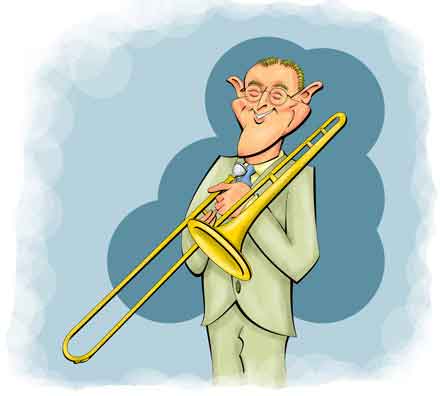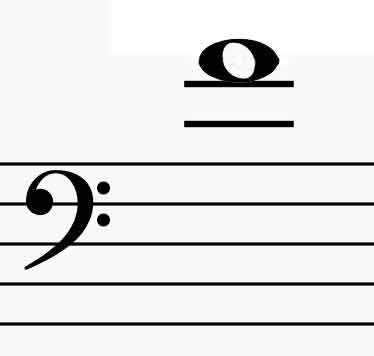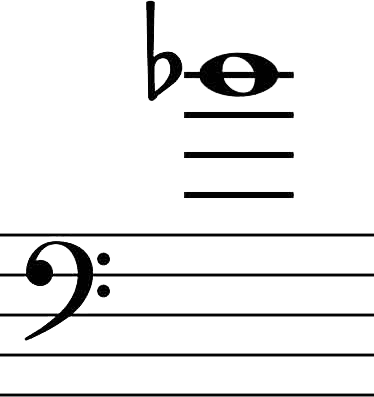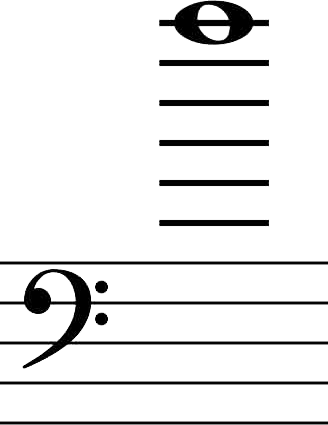Tommy Dorsey
King of the High C-Sharps

(Click to Zoom In and Out)
WARNING!!!!!
THE FOLLOWING HAS AN EXTREMELY HIGH NERD CONTENT AND SHOULD BE AVOIDED BY THOSE AVERSE TO THE PROPAGATION OF NERDISM.
First of all let's listen to a trumpet version of the first couple of bars of "I'm Getting Sentimental Over You" based on the playing of Maynard Ferguson.
I'm Getting Sentimental Over You
Excerpt for Trumpet
(Audio file created with MuseSCORE)
Impressive, is it not? I mean we go up to a screamin' D-sharp. What virtuosity! What technique!
Now listen to the same passage which is fashioned after the playing of Tommy Dorsey.
I'm Getting Sentimental Over You
Excerpt for Trombone
(Audio file created with MuseSCORE)
Now if you hear the original, it's Tommy's smooth and expressive playing - admittedly lacking in a (ptui) computer generated file - that brings the accolades. On the other hand that Tommy goes up to the high C-sharp (the same as D-sharp1 on a trumpet) doesn't bring much comment even by Tommy's fans. After all it doesn't sound as high.
Footnote
The trumpet is what they call a "transposing" instrument. When you see a note written for a transposing instrument it comes out as something else.
So when someone who's playing a "B-flat trumpet" sees a C written on the staff, what they play comes out as a B-flat. Similarly if someone plays an "F French horn", a note written as a C sounds like an F.
But when a trombonist plays a C it comes out as a C. So why is the instrument called a B-flat trombone? It should be called a C trombone. We see a contradiction.
Well, music for a trombone is usually written using the bass clef, 𝄢. Music on a bass clef comes out as it's written.
Now there is some music for the trombone particularly from the olden days that was written in the treble clef, 𝄞. In that case if the player sees a note written as a C, he plays a B-flat.
If that doesn't make sense, remember no one today made the rules.
And of course, it isn't. In absolute pitch the trumpet sounds an octave above a trombone. So a trombone player has to make the same embouchureal efforts to produce a note that comes out an octave lower - efforts that rarely draw the same approbation as does the playing of a "high-noter" trumpeter. If that's not enough salt to rub into an already festering wound, if a trombone player is reading music written for a "British Brass Band" it will be notated in the treble clef. In that case the music is also written an octave higher than played, for crying out loud!
One world famous trombone teacher2 advised orchestral conductors not to make the trombonist play extended times above a simple high F ( ). And most students find learning the notes above the F the first real technical challenge. Ironically for some a high C (
). And most students find learning the notes above the F the first real technical challenge. Ironically for some a high C ( ) is a bit easier to play than the B-flat (
) is a bit easier to play than the B-flat ( ) - a whole step lower.
) - a whole step lower.
Footnote
Actually as Snoopy said about world famous grocery clerks, there's really not much more than a dozen world famous trombone teachers.
Tommy's high C-sharp, by the way, is also the highest note in the famous - or infamous - trombone passage in Maurice Ravel's Bolero (although Maurice wrote the note as a D-flat).
Bolero - Excerpt
(Audio file created with MuseSCORE)
Although not quite The Bluebells of Scotland, the trombone solo in Bolero is one of the more demanding in the orchestral repertoire. As all true Ravel fans know, part of the fun of listening to a live broadcast of Bolero is to see if the trombone player makes a hash of it.
Of course, everybody's heard what's called the "Trombone Bolero Disaster" where the trombonist has a massive meltdown. No, instead we're talking about live performances of major symphony orchestras3.
Footnote
It needs to be a live performance, of course. If it's a studio recording, they'll simply do another take.
There is an excuse to plead. When playing Bolero the trombone section sits through the first half of the piece - about 7 minutes - without playing at all. So the soloist has to come in "cold" on the high B-flat four lines above the bass clef staff. Then he moves up to the D-flat. You'll even hear first class elite musicians flub the part.
As far as "I'm Getting Sentimental Over You", one way out is to play in another key which drops the high note down a bit. Even the virtuosi sometimes do this. The legendary Jack Teagarden played the song in the key of C which lowers the C-sharp to a B-natural ( ) - a whole tone lower than in Tommy's arrangement. And the playing of Chilean trombonist Héctor Briceño (known professionally as Parquímetro4) only went up to an A (
) - a whole tone lower than in Tommy's arrangement. And the playing of Chilean trombonist Héctor Briceño (known professionally as Parquímetro4) only went up to an A ( )5.
)5.
Footnote
Lest fans of Jack or Parquímetro go into spittle-flinging diatribes in what they may take as a challenge to Jack's and Parquímetro's ability, playing a bit lower also produces a more mellow sound than the original higher version. So there's artistry as well as technique in the decision.
The high B-flat ( ) - the first note of the Bolero solo - is the highest note in traditional trombone pedagogy - and you'll still see this limit in introductory instruction manuals. It's a point of interest that the Bolero solo was reportedly inspired by the playing of a French jazz musician noted for his ability to play in the upper register. Bolero premiered as a ballet in 1928 and as a concert piece in 1930. And since we know Tommy played "I'm Getting Sentimental Over You" in 1932, it seems that in the early 20th century it was expected that a top flight trombonist should find playing a C-sharp/D-flat pretty pud.
) - the first note of the Bolero solo - is the highest note in traditional trombone pedagogy - and you'll still see this limit in introductory instruction manuals. It's a point of interest that the Bolero solo was reportedly inspired by the playing of a French jazz musician noted for his ability to play in the upper register. Bolero premiered as a ballet in 1928 and as a concert piece in 1930. And since we know Tommy played "I'm Getting Sentimental Over You" in 1932, it seems that in the early 20th century it was expected that a top flight trombonist should find playing a C-sharp/D-flat pretty pud.
But once upon a time the high B-flat was the limit for even virtuoso players. In 1878 in Kronstadt, Russia, Nikolai Rimsky-Korsakov premiered his highly popular but (let's admit it) overrated Concerto for Trombone and Wind Orchetra (Концерт для тромбона с Духовым оркестром / Kontsert dlya trombona s Dukhovym orkestrom). Although in the cadenzas some modern editions go up to über high F ( ) the original score has no note above the traditional "high" B-flat6. Evidently Nikolai didn't think the soloist at the first performance - who we only know as Leonov - could play like Tommy Dorsey.
) the original score has no note above the traditional "high" B-flat6. Evidently Nikolai didn't think the soloist at the first performance - who we only know as Leonov - could play like Tommy Dorsey.
Footnote
And once more lest fans of Rimsky misconstrue the comments as a belittling of his ability, not all works by even great composers of equal quality and everyone is allowed an off day. Certainly Beethoven's Ninth Symphony is vastly superior to (bleah) Wellington's Victory and Shostakovich's Jazz Suites ain't remotely jazz.
Although Nikolai's concerto was written around 1877 and premiered the next year, the American premiere wasn't until 1952 - a very good year - when it was performed in New York City's Central Park and conducted by Edwin Goldman. The soloist was Davis Shuman who was Professor of Trombone at Julliard and who provided the basis for the modern editions.
Probably the best recording of Rimsky's trombone concerto is - not surprisingly - by the current principal trombonist of the New York Philharmonic, Joseph Alessi. He was accompanied by the University of Florida Wind Symphony conducted by Professor David Waybright. Maestro Alessi hits the extra high F (  ) with ease and finishes up the concerto with the high B-flat (
) with ease and finishes up the concerto with the high B-flat (  ) - a full two octaves above what Rimsky wrote in his score.
) - a full two octaves above what Rimsky wrote in his score.
References
Trombone Technique, Denis Wick, Oxford University Press, 1971.
"Trombone History: 20th Century", Will Kimball, willkimball.com.
"This Trombone Fail Will Make You Laugh and Then Immediately Feel Awful for Laughing", Classic FM, December 3, 2018.
"Trombone Concerto in B-Flat Major", Rock Stars", David Waybright (Conductor), Joseph Alessi (Soloist), University Of Florida Wind Symphony (Performers), Nikolay Rimsky-Korsakov (Composer), Mark Records, February 7, 2012.
Concerto for Trombone: For Trombone or Trumpet, Piano Reduction, Nikolay Rimsky-Korsakov (Composer), Davis Shuman (Editor), Alfred Music, 1999.
MuseScore, musescore.org.
Peanuts, Charles Schulz, August 25, 1970.